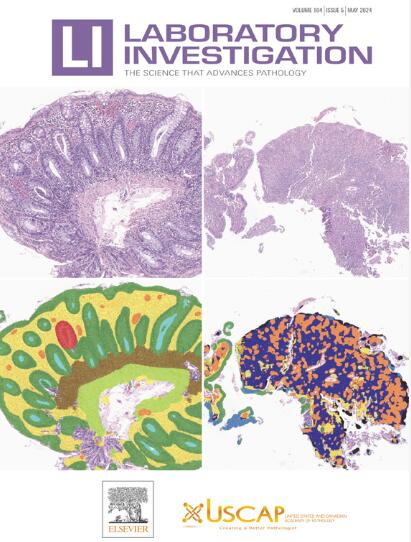在评估肺癌新辅助治疗后的病理反应时,全切片成像与传统光学显微镜的一致性。
IF 5.1
2区 医学
Q1 MEDICINE, RESEARCH & EXPERIMENTAL
引用次数: 0
摘要
病理反应是许多正在进行的新辅助治疗方案(包括免疫检查点阻断和化疗)临床试验的终点。对玻璃载玻片进行整片扫描可生成高分辨率的数字图像,并可通过图像分析工具进行远程审查和潜在测量,但数字扫描与玻璃载玻片病理反应评估的一致性还有待评估。这种验证超越了以往侧重于确定手术病理诊断的一致性研究,因为它需要对肿瘤、坏死和消退进行定量评估。此外,由于病理反应评估被用作终点,这种一致性研究具有监管意义。本研究有两个目的:首先,确定玻璃切片和数字扫描评估的病理反应之间的一致性;其次,确定病理学家在确定病理反应时是否能从使用测量工具中获益。为此,我们对 64 份非小细胞肺癌标本的 H&E 染色玻璃切片进行了残留有活力肿瘤百分比(%RVT)的目测评估。完全病理反应(pCR,0% RVT)和主要病理反应(MPR,≤10% RVT)的数字读数与玻璃读数的灵敏度和特异性均大于 95%。当将RVT%视为连续变量时,数字读数与玻璃读数的类内相关系数为0.94。病理学家对残留肿瘤和肿瘤床区域的注释支持了对病理反应的目测评估。在单独的 H&E 染色玻璃切片子集中,采用了几种测量方法来量化%RVT。病理学家的估算结果与测量的 RVT 百分比高度吻合。这项研究表明,使用光学显微镜评估的玻璃切片与用于病理反应评估的数字全切片图像之间具有高度一致性。病理学家不需要测量工具就能根据玻片注释生成可靠的 %RVT 值。这些发现对改进临床工作流程和多点临床试验具有广泛的意义。本文章由计算机程序翻译,如有差异,请以英文原文为准。
Concordance of Whole-Slide Imaging and Conventional Light Microscopy for Assessment of Pathologic Response Following Neoadjuvant Therapy for Lung Cancer
Pathologic response is an endpoint in many ongoing clinical trials for neoadjuvant regimens, including immune checkpoint blockade and chemotherapy. Whole-slide scanning of glass slides generates high-resolution digital images and allows for remote review and potential measurement with image analysis tools, but concordance of pathologic response assessment on digital scans compared with that on glass slides has yet to be evaluated. Such a validation goes beyond previous concordance studies, which focused on establishing surgical pathology diagnoses, as it requires quantitative assessment of tumor, necrosis, and regression. Further, as pathologic response assessment is being used as an endpoint, such concordance studies have regulatory implications. The purpose of this study was 2-fold, which was as follows: first, to determine the concordance between pathologic response assessed on glass slides and that assessed on digital scans, and second, to determine if pathologists benefited from using measurement tools when determining pathologic response. To that end, hematoxylin and eosin–stained glass slides from 64 non–small cell lung carcinoma specimens were visually assessed for percent residual viable tumor (%RVT). The sensitivity and specificity for digital vs glass reads of pathologic complete response (0% RVT) and major pathologic response (≤10% RVT) were all >95%. When %RVT was considered as a continuous variable, the intraclass correlation coefficient of digital vs glass reads was 0.94. The visual assessments of pathologic response were supported by pathologist annotations of residual tumor and tumor bed areas. In a separate subset of hematoxylin and eosin–stained glass slides, several measurement approaches to quantifying %RVT were performed. Pathologist estimates strongly reflected measured %RVT. This study demonstrates the high level of concordance between glass slides evaluated using light microscopy and digital whole-slide images for pathologic response assessments. Pathologists did not require measurement tools to generate robust %RVT values from slide annotations. These findings have broad implications for improving clinical workflows and multisite clinical trials.
求助全文
通过发布文献求助,成功后即可免费获取论文全文。
去求助
来源期刊

Laboratory Investigation
医学-病理学
CiteScore
8.30
自引率
0.00%
发文量
125
审稿时长
2 months
期刊介绍:
Laboratory Investigation is an international journal owned by the United States and Canadian Academy of Pathology. Laboratory Investigation offers prompt publication of high-quality original research in all biomedical disciplines relating to the understanding of human disease and the application of new methods to the diagnosis of disease. Both human and experimental studies are welcome.
 求助内容:
求助内容: 应助结果提醒方式:
应助结果提醒方式:


